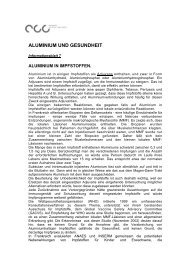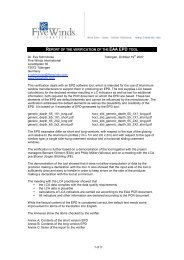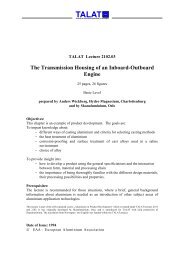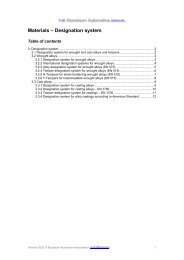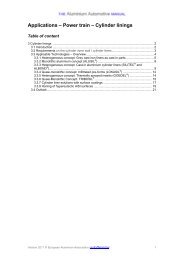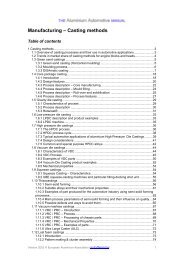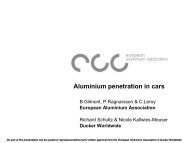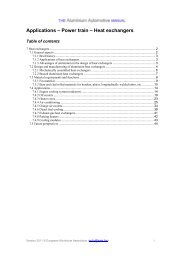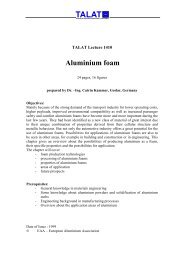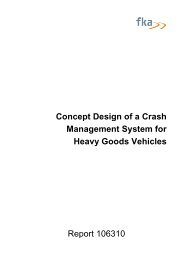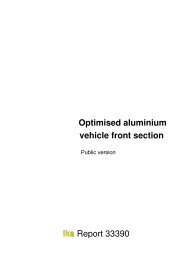aluminium in commercial vehicles - European Aluminium Association
aluminium in commercial vehicles - European Aluminium Association
aluminium in commercial vehicles - European Aluminium Association
You also want an ePaper? Increase the reach of your titles
YUMPU automatically turns print PDFs into web optimized ePapers that Google loves.
EUROPEAN ALUMINIUM ASSOCIATION ALUMINIUM IN COMMERCIAL VEHICLES CHAPTER VII 103<br />
5. Tapp<strong>in</strong>g<br />
Threads <strong>in</strong> <strong>alum<strong>in</strong>ium</strong> may be<br />
made, when other jo<strong>in</strong><strong>in</strong>g techniques<br />
are not applicable6 .<br />
6. In a connection, where cont<strong>in</strong>uous<br />
jo<strong>in</strong><strong>in</strong>g methods such as weld<strong>in</strong>g or<br />
bond<strong>in</strong>g are used, no additional fasteners<br />
should be applied.<br />
Threaded holes <strong>in</strong> <strong>alum<strong>in</strong>ium</strong> should<br />
only be used where no other possibility<br />
exists and the yield strength of the metal<br />
exceeds 200 N/mm2. The bear<strong>in</strong>g length<br />
of the bolt should be 1,5 x diameter of<br />
the bolt. If the bolts must be used for<br />
repeated loosen<strong>in</strong>g and tighten<strong>in</strong>g,<br />
<strong>in</strong>serts should be applied e.g. Helicoils.<br />
If threads are made <strong>in</strong> <strong>alum<strong>in</strong>ium</strong>,<br />
care should be taken to<br />
ensure that the thread length is<br />
sufficient for the purpose. The<br />
thread length may be between 1<br />
and 2 times the major diameter<br />
of the threads, and must depend<br />
on the application, the alloy as<br />
well as the temper of the material.<br />
For example, the necessary<br />
thread length of a high strength<br />
6000 alloy <strong>in</strong> T6 may be 1.2 times<br />
the major thread diameter.<br />
Conversely a softer alloy demands<br />
a longer thread length.<br />
TABLE VII.2<br />
There are two methods of tapp<strong>in</strong>g:<br />
• by chip removal,<br />
• by upsett<strong>in</strong>g.<br />
DIAMETER OF PILOT HOLES FOR THREAD TAPPING<br />
∅ nom<strong>in</strong>al 4 5 6 8 10 12 14 16 18 20<br />
Pitch 0.70 0.80 1 1.25 1.50 1.75 2 2 2.5 2.5<br />
Diameter 3.2 4.2 4.9 6.6 8.3 10 11.7 13.7 15 17<br />
5.1. Chip removal<br />
Only taps with straight threads<br />
should be used to avoid seiz<strong>in</strong>g<br />
the metal at the flanks. Table<br />
VII.2 gives diameters for pilot<br />
holes for tapp<strong>in</strong>g <strong>alum<strong>in</strong>ium</strong><br />
alloys <strong>in</strong> the 5000 and 6000<br />
series. Pilot holes for these alloys<br />
<strong>in</strong> the annealed condition must<br />
be some 3-5% bigger than <strong>in</strong><br />
Table VII.2 and for cast<strong>in</strong>gs with<br />
12 and more % silicon content<br />
some 2% smaller.<br />
The cutt<strong>in</strong>g speed varies from 10<br />
to 50 m/m<strong>in</strong> depend<strong>in</strong>g on the<br />
mach<strong>in</strong>e and method of clamp<strong>in</strong>g<br />
the tap, whether float<strong>in</strong>g or<br />
<strong>in</strong> a chuck. Cool<strong>in</strong>g is done with<br />
cutt<strong>in</strong>g oil.



